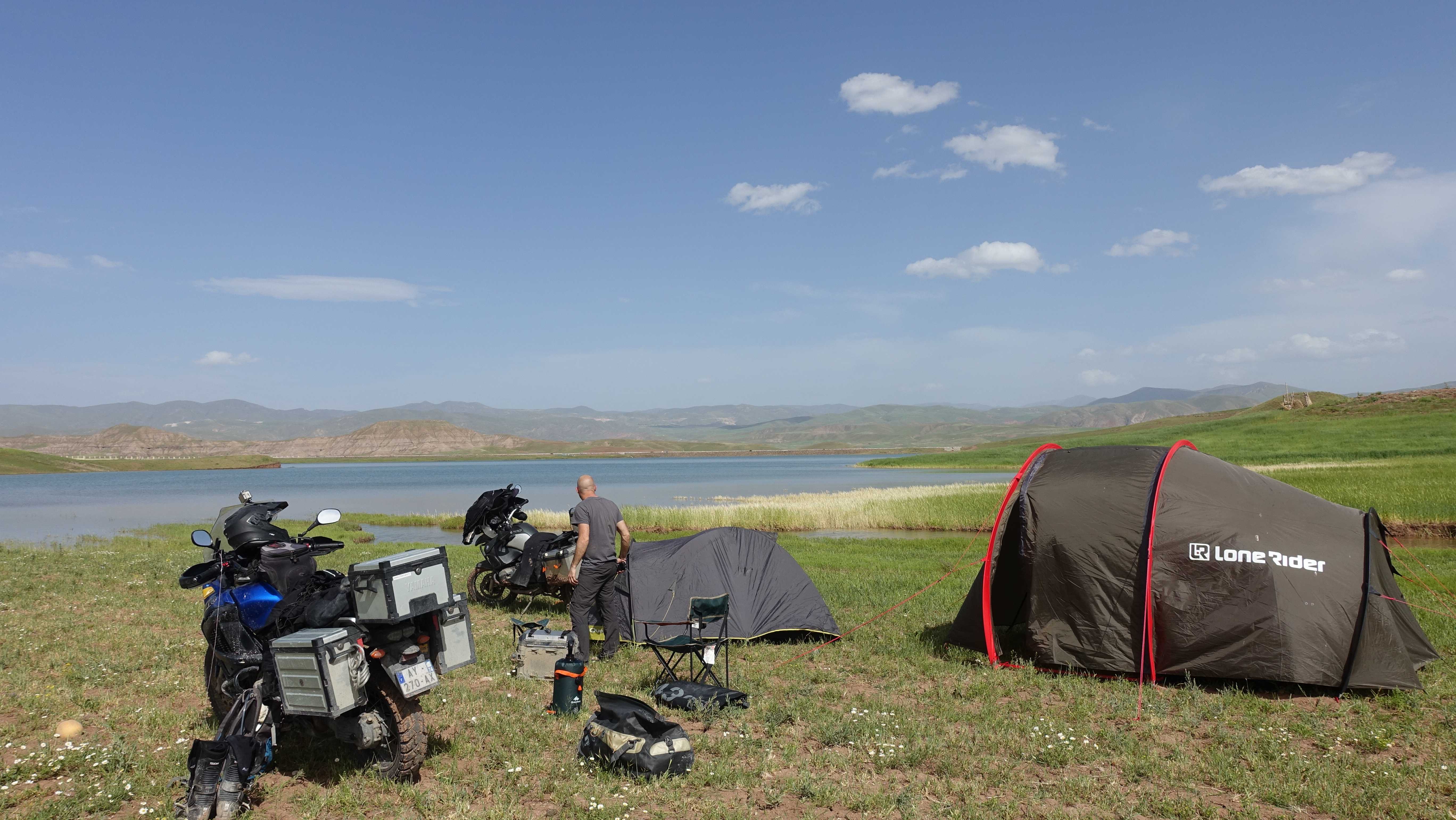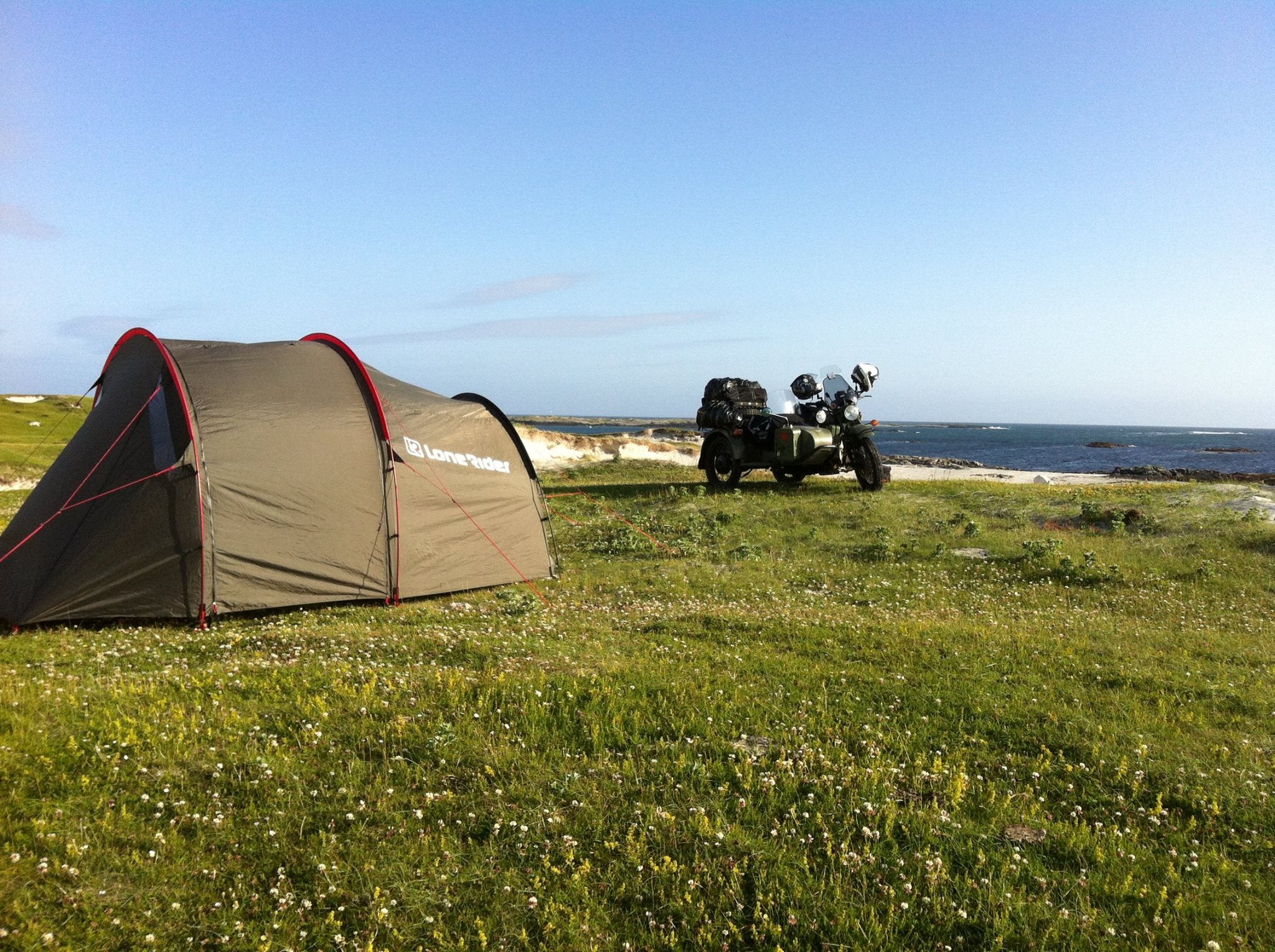8 Essential Tips For Trouble-Free Motorcycle Camping

When motorcycling and camping unite, something magical happens.
Each activity alone—whether riding across desolate areas of Argentina’s Tierra del Fuego, stopping for a night an American BDR route, or camping under the Northern Lights—gets emotions flowing in its own way.
But, again, when they are combined, something magical happens.
This is especially true when everything goes smoothly. The route to smooth motorcycle camping? Proactive planning.
We’ve spent years perfecting the art of motorcycle and camping, and we’ll continue to explore these topics on our blog.
But let’s begin with absolute essentials that all motorcycle campers should immediately implement into their plans: the Top 8 Essential Tips for Trouble-Free Motorcycle Camping.
Pre-Camp
1. Know Your Motorcycle In and Out
Begin with knowing your bike, and at the very least the basics of maintenance (though the more you know the better). Start from the tires up, checking tire pressure, oil, brake/clutch fluids, and adjustment of all controls. Just having your clutch/brake levers in the most optimal position for comfort while sitting and standing can make a ride much happier.
Also, learn to work on motorcycles, especially the basics like changing a tire tube, or if you have tubeless rims plugging a tire.
We’ll have more in upcoming blogs, but for now research techniques by globetrotting travelers like Helge Pedersen.
Remember, to enjoy camping, you need to get there first. And it all begins with a trouble-free bike, and knowledge to make repairs.
2. Invest in Good Gear for Riding and Camping
Don’t skimp on good riding or camping gear. As for riding gear, the absolute musts for serious adventure rides are good base layers, and protective gear (jacket, pants, boots) that is waterproof and offers optimal ventilation.
In regards to camping, a top-performing tent and sleeping bag are paramount to comfort in nature. The more comfortable you sleep, the better the energy and riding/exploring will be the following day.
We purposely designed two tents for the exact reason of what level of comfort is needed; our MotoTent offers enough space to bring loads of home-style comfort to the trail, and even features a canopy for your motorcycle and vestibule for gear. This tent was built by bikers for bikers, and at 12 lbs. (5.44 kg), the MotoTent is the lightest one on the market that features storage for your motorcycle.
Our other option is the ADV Tent, which is for those adventure motorcyclists who like to be placed directly in nature and love to travel light. This two person tent weighs just 7.38 lbs (3.35 kg), and packs away in a small 16.1" x 5.9" (41 x 15 cms) bag.
3. Don’t Overpack, But Remember the Essentials
Again, proactiveness is key to a smooth motorcycle camping experience. When packing, sit back and imagine yourself going throughout a day of waking up, riding, setting up camp, and sleeping.
Think like “I began the day brushing my teeth and washing my face and hands” to “I need to charge my phone at night”.
Then make the list, which should include all toiletries, TP, solar chargers, camp shorts, camp shoes, cooking utensils, food, etc. Then think of the utilitarian needs, such as a Swiss Army knife or Leatherman, first-aid kit, headlight lamp, hand sanitizer and a ground cloth for under the tent if needed (simple PV-coated nylon tarp will do!).
Just don’t go overboard; people typically overpack instead of underpack. Again, imagine your day from waking up to sleeping, and make a checklist of things. Then go through that list and get rid of stuff you likely won’t use, like those four extra t-shirts that always come back home clean and folded.
Want to make packing easy? Check out our luggage, including our semi-rigid MotoBags.
4. Pack Your Motorcycle Correctly
When packing, regardless of using hard or soft bags, try getting the heaviest items closest to the center of gravity. Make sure the bags are balanced out with weight, and keep similar items together, such as a sleeping bag and clothes, or a tent and tools. We always pack away an extra bungee cargo net.
They can hold anything down, and help save time when something needs to quickly be secured.
Campsite
5. Choosing a Campsite
Sometimes what you see as having a beautiful scenery can make for a horrible night of camping, especially in lower areas where rain or fog can collect. Note that any areas with any type water collection will provide a perfect hosting ground for mosquitoes and other bugs, and heavy morning fog leads to uncomfortable moisture in your tent.
Search for higher grounds that are flat, and lacking rocks, ant hills or high grass—the latter also a perfect hosting ground for pests like ticks and bees.
Before pitching a tent, lay on the ground to see if it’s actually comfortable. We’ve all pitched tents just to realize at bedtime that the surface has us squirming for comfort. Be proactive by laying on the ground and finding the comfort before pitching the tent.
 Featured product: Motorcycle tent - MotoTent
Featured product: Motorcycle tent - MotoTent
6. Park Bike and Give it a Once Over
Just like laying on the ground to find optimal comfort for sleep, figure out where to park the bike so that it’s out of the way. The reasons for this are security from others in the back country, and not having to scramble around at night if your steed is in the way of the perfect place to set up a fire pit.
Before pitching the tent, we recommend giving the bike a quick once over — checking tire pressures, visible leaks, or anything else that can jeopardize the next day’s ride and safety.
Also, when riding, use the bike to your advantage such as a place to hang gear. A good practice is to check the gear for any type of bugs (ticks especially if you’re in such areas), and let it dry out before storing it away for the night. This is also one of the reasons we created the MotoTent — the vestibule area is perfect for keeping gear out of the elements at night while you sleep.
7. Camping and Cooking Basics
Another proactive measure for camping is learning the basics of cooking on the trail with the least amount of cookware available (stay tuned for a future blog post!). Some foods, like pasta, are easy to pack and only require some boiling, and for good flavor only require packets of dressing, which pack away easily.
Also, always remember aluminum foil for cooking fresh foods on a direct heat source (potato, freshly-caught fish, hot dogs... you name it!).
8. Keep Pests and Animals Away
Let’s start with those pesky little bugs. They can destroy a night of camping as fast as a flat tire can destroy a great day of riding. The key, once again, is proactiveness.
The first defense is a good bug spray. Water repellent spray is best, especially if moisture is present. If you want natural, there are plenty of essential oil blends that work as good as DEET.
Speaking of water, once again, stay away! You already have received education to not pitch a tent near standing water. The reason is simple—mosquitoes thrive on H2O. But let’s get a bit deeper… mosquitoes typically lay eggs in moist settings, and these eggs hatch into larvae that mature in water.
Next, remember to keep your tent’s screens zippered shut; one mosquito or ant or any type of pest can quickly wake you out of a deep sleep. Also, try to keep the zippers at the uppermost closing portion of the screen; tiny ground-roaming bugs can creep in even if there’s a slight opening.
I saved scent for last of the bug talk, because it brings us into the animal talk. Animals and bugs thrive on fragrance such as deodorant or crazy scents of hand sanitizer.
Bugs are attracted to these fragrances, and so are animals, such as bear, that can smell something tasteful miles away. Learn a lesson we did once??- don’t bring apple pie-scented hand sanitizer for cleaning your hands. There were more animals present that night than ever.
Use a non-scented hand sanitizer, and, though you don’t have to go full hippie, try using the least-fragrant deodorant or soap.
Now onto food. When cooking, it’s naturally going to attract animals. Keep your camp clean of all food scraps or anything that can smell of food. A few campers go as far as burying food scraps a few hundred feet away from the camping location to keep the animals away. Also, never sleep with food inside your tent; wild animals will do anything to secure a meal. Remaining food is best kept sealed in Ziplock bags or other containers that don’t exhume smells, and in sealed panniers.
 Featured product: Motorcycle tent - MotoTent
Featured product: Motorcycle tent - MotoTent
OK, we’ll say it one last time: camping via motorcycle is magical. There is absolutely no better way to enjoy nature than adventure riding and camping.
But sometimes these experiences can turn out miserable due to lack of preparation.
Use these tips to better prepare yourself for a future motorcycle camping trip. And to keep these times magical, remember that whatever you bring into nature, bring out.
It’s not only a sign of respect for Mother Nature, but also your fellow adventure motorcyclist.